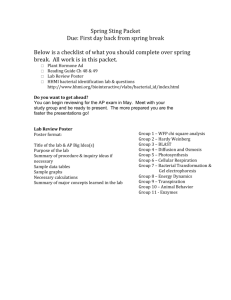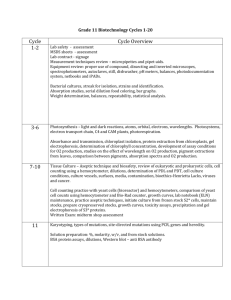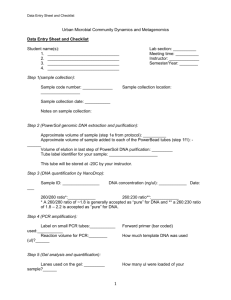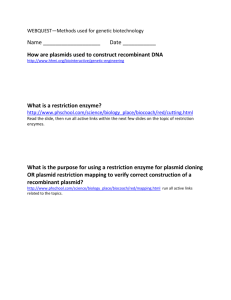HHMI: BioInteractive Virtual Lab Name BACTERIAL ID LAB
advertisement
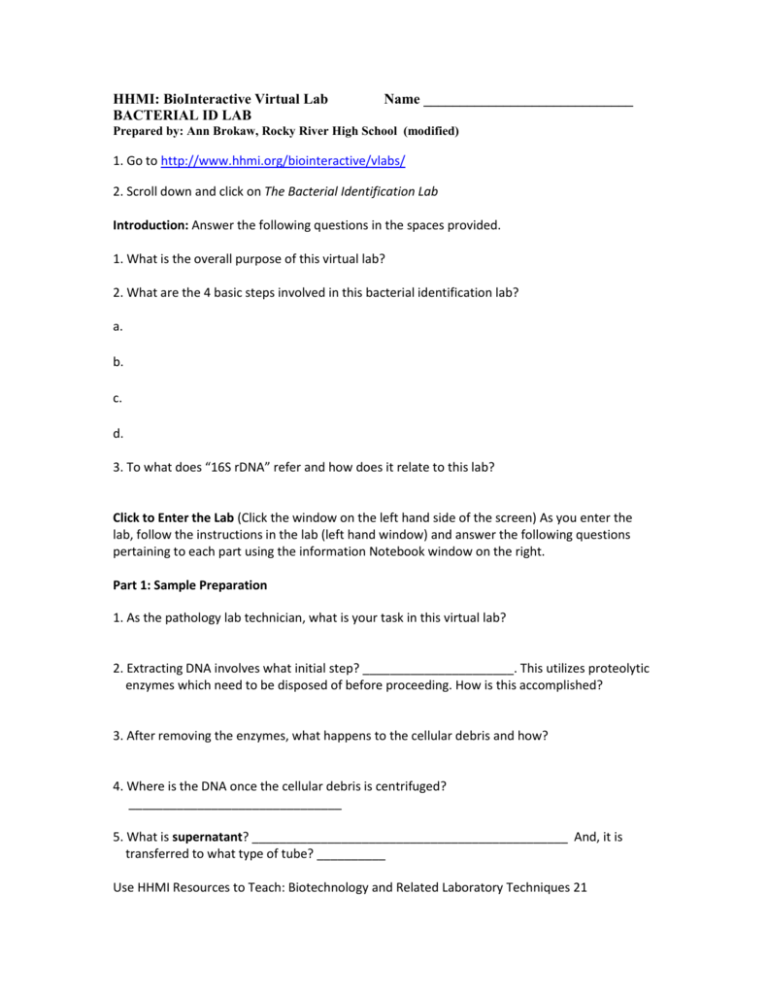
HHMI: BioInteractive Virtual Lab BACTERIAL ID LAB Name _____________________________ Prepared by: Ann Brokaw, Rocky River High School (modified) 1. Go to http://www.hhmi.org/biointeractive/vlabs/ 2. Scroll down and click on The Bacterial Identification Lab Introduction: Answer the following questions in the spaces provided. 1. What is the overall purpose of this virtual lab? 2. What are the 4 basic steps involved in this bacterial identification lab? a. b. c. d. 3. To what does “16S rDNA” refer and how does it relate to this lab? Click to Enter the Lab (Click the window on the left hand side of the screen) As you enter the lab, follow the instructions in the lab (left hand window) and answer the following questions pertaining to each part using the information Notebook window on the right. Part 1: Sample Preparation 1. As the pathology lab technician, what is your task in this virtual lab? 2. Extracting DNA involves what initial step? ______________________. This utilizes proteolytic enzymes which need to be disposed of before proceeding. How is this accomplished? 3. After removing the enzymes, what happens to the cellular debris and how? 4. Where is the DNA once the cellular debris is centrifuged? _______________________________ 5. What is supernatant? ______________________________________________ And, it is transferred to what type of tube? __________ Use HHMI Resources to Teach: Biotechnology and Related Laboratory Techniques 21 Part 2: PCR Amplification 1. What does PCR stand for? And what is the purpose of PCR? 2. How is the desired portion of DNA obtained? 3. Step 1: Add Master Mix a. What does the Master Mix contain? b. What are primers? c. Once the primers bind, what occurs next? d. What does “highly conserved” mean? e. Why is this important in this lab? f. What does “highly variable” mean? g. Why is this important in this lab? h. What is missing in the negative control tube? i. What is present in the positive control that is not in the negative control? 4. Step 2: Run PCR a. Be sure to watch the virtual lab animation before proceeding to the following questions. b. What is the name of each step of a cycle, the temperature of each, and time? i. ___________________________________ ii. ___________________________________ iii. ___________________________________ c. Define “Melt” (also called Denature): d. Define “Anneal”: e. Define “Extend”: Use HHMI Resources to Teach: Biotechnology and Related Laboratory Techniques 22 f. After 8 cycles, how many copies of the desired DNA have been synthesized? _______ g. After 29 cycles?___________________ Part 3: PCR Purification 1. Approximately how long is the 16s rDNA (bp)? ___________ 2. Running an electrophoresis gel at this point is very useful. Why? 3. The gel should contain three lanes. What should you see in each lane after running the gel? a. b. c. 4. The gel is not run in this virtual lab. In order to purify the PCR product, a microconcentrator column is utilized. (Proceed through the virtual lab steps.) What should the final collection tube contain? Part 4: Sequencing Preparation 1. Click on “Learn about cycle sequencing before proceeding.” What is cycle sequencing? (From the first 2 paragraphs, take notes on this technique in the space provided.) What is the significance of the fluorescently tagged dideoxynucleotides? 2. One problem that arises in this technique is the fact that replication must start at the same place on the target DNA each time. How is this problem avoided? 3. (Back to Part 4) Where do scientists obtain primers to be used in PCR and in this technique? 4. What do the green and blue tubes contain? 5. Be sure to watch the virtual lab animation before proceeding to Part 5 Part 5: DNA Sequencing 1. What does each of the tubes contain? 2. What remains to be done? Use HHMI Resources to Teach: Biotechnology and Related Laboratory Techniques 23 3. What is Gel Electrophoresis? 4. How do DNA molecules move in relation to charge? Why? 5. What is the purpose of the laser beam? Why is this significant? 6. Be sure to watch the virtual lab animation before proceeding to Part 6 Part 6: DNA Sequence Analysis 1. Click on “Learn about the science behind sequence matching.” What is the ultimate goal of this analysis? 2. What is “homology”? 3. A comprehensive database is needed for this analysis as well as an adequate program for searching the database. BLAST is one such program, because it offers a good combination of what? 4. What is the major assumption when drawing evolutionary relationships between organisms based on DNA sequences? 5. Go back to Part 6 and click on “Learn more about BLAST search results.” Explain what the “Score (bits)” means on an actual BLAST search result. 6. As far as the “E Value” is concerned, what does an E-value of 3 or less represent? 7. Go back to part 6 and proceed through the instructions in the right hand notebook window. Hints: “Ctrl A” will select all the data in the pop-up window, “Ctrl C” will copy it, and “Ctrl V” will paste it into the NCBI website (large yellow box at top of the blastn search page) 8. When the blast results appear, scroll down below the color key to the significant alignments, and then go back to the virtual lab window (left) and follow the instructions. 9. What is the scientific name of the bacteria you sequenced? _________________________ Use HHMI Resources to Teach: Biotechnology and Related Laboratory Techniques 24 10. After completing sample A, Fill in the data chart. Perform DNA Sequence Analysis on the other sample. Click on the samples tab and follow the instructions. Fill in the data chart in the appropriate spaces after doing your BLAST search. SAMPLE LETTER A B C D E F SCIENTIFIC NAME BRIEF DESCRIPTION
